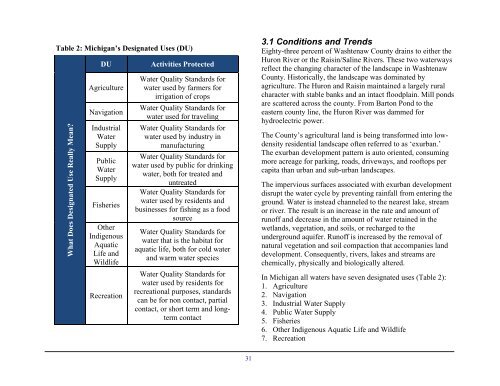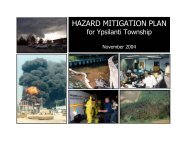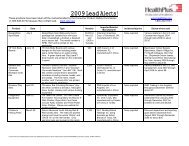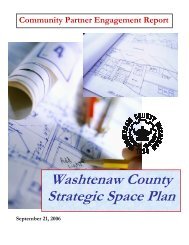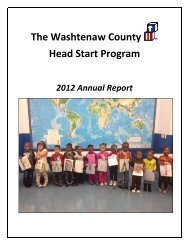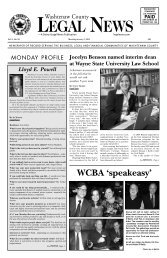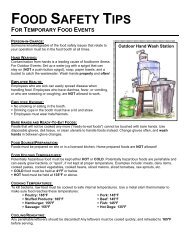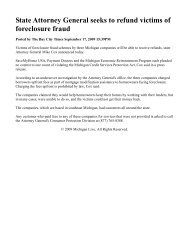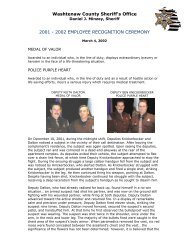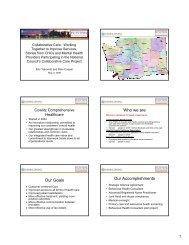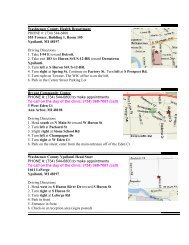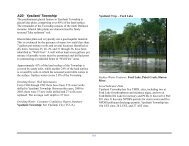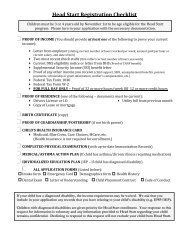Water Protection Activities in Washtenaw County
Water Protection Activities in Washtenaw County
Water Protection Activities in Washtenaw County
You also want an ePaper? Increase the reach of your titles
YUMPU automatically turns print PDFs into web optimized ePapers that Google loves.
Table 2: Michigan’s Designated Uses (DU)<br />
What Does Designated Use Really Mean?<br />
DU <strong>Activities</strong> Protected<br />
Agriculture<br />
Navigation<br />
Industrial<br />
<strong>Water</strong><br />
Supply<br />
Public<br />
<strong>Water</strong><br />
Supply<br />
Fisheries<br />
Other<br />
Indigenous<br />
Aquatic<br />
Life and<br />
Wildlife<br />
Recreation<br />
<strong>Water</strong> Quality Standards for<br />
water used by farmers for<br />
irrigation of crops<br />
<strong>Water</strong> Quality Standards for<br />
water used for travel<strong>in</strong>g<br />
<strong>Water</strong> Quality Standards for<br />
water used by <strong>in</strong>dustry <strong>in</strong><br />
manufactur<strong>in</strong>g<br />
<strong>Water</strong> Quality Standards for<br />
water used by public for dr<strong>in</strong>k<strong>in</strong>g<br />
water, both for treated and<br />
untreated<br />
<strong>Water</strong> Quality Standards for<br />
water used by residents and<br />
bus<strong>in</strong>esses for fish<strong>in</strong>g as a food<br />
source<br />
<strong>Water</strong> Quality Standards for<br />
water that is the habitat for<br />
aquatic life, both for cold water<br />
and warm water species<br />
<strong>Water</strong> Quality Standards for<br />
water used by residents for<br />
recreational purposes, standards<br />
can be for non contact, partial<br />
contact, or short term and longterm<br />
contact<br />
31<br />
3.1 Conditions and Trends<br />
Eighty-three percent of <strong>Washtenaw</strong> <strong>County</strong> dra<strong>in</strong>s to either the<br />
Huron River or the Rais<strong>in</strong>/Sal<strong>in</strong>e Rivers. These two waterways<br />
reflect the chang<strong>in</strong>g character of the landscape <strong>in</strong> <strong>Washtenaw</strong><br />
<strong>County</strong>. Historically, the landscape was dom<strong>in</strong>ated by<br />
agriculture. The Huron and Rais<strong>in</strong> ma<strong>in</strong>ta<strong>in</strong>ed a largely rural<br />
character with stable banks and an <strong>in</strong>tact floodpla<strong>in</strong>. Mill ponds<br />
are scattered across the county. From Barton Pond to the<br />
eastern county l<strong>in</strong>e, the Huron River was dammed for<br />
hydroelectric power.<br />
The <strong>County</strong>’s agricultural land is be<strong>in</strong>g transformed <strong>in</strong>to lowdensity<br />
residential landscape often referred to as ‘exurban.’<br />
The exurban development pattern is auto oriented, consum<strong>in</strong>g<br />
more acreage for park<strong>in</strong>g, roads, driveways, and rooftops per<br />
capita than urban and sub-urban landscapes.<br />
The impervious surfaces associated with exurban development<br />
disrupt the water cycle by prevent<strong>in</strong>g ra<strong>in</strong>fall from enter<strong>in</strong>g the<br />
ground. <strong>Water</strong> is <strong>in</strong>stead channeled to the nearest lake, stream<br />
or river. The result is an <strong>in</strong>crease <strong>in</strong> the rate and amount of<br />
runoff and decrease <strong>in</strong> the amount of water reta<strong>in</strong>ed <strong>in</strong> the<br />
wetlands, vegetation, and soils, or recharged to the<br />
underground aquifer. Runoff is <strong>in</strong>creased by the removal of<br />
natural vegetation and soil compaction that accompanies land<br />
development. Consequently, rivers, lakes and streams are<br />
chemically, physically and biologically altered.<br />
In Michigan all waters have seven designated uses (Table 2):<br />
1. Agriculture<br />
2. Navigation<br />
3. Industrial <strong>Water</strong> Supply<br />
4. Public <strong>Water</strong> Supply<br />
5. Fisheries<br />
6. Other Indigenous Aquatic Life and Wildlife<br />
7. Recreation


